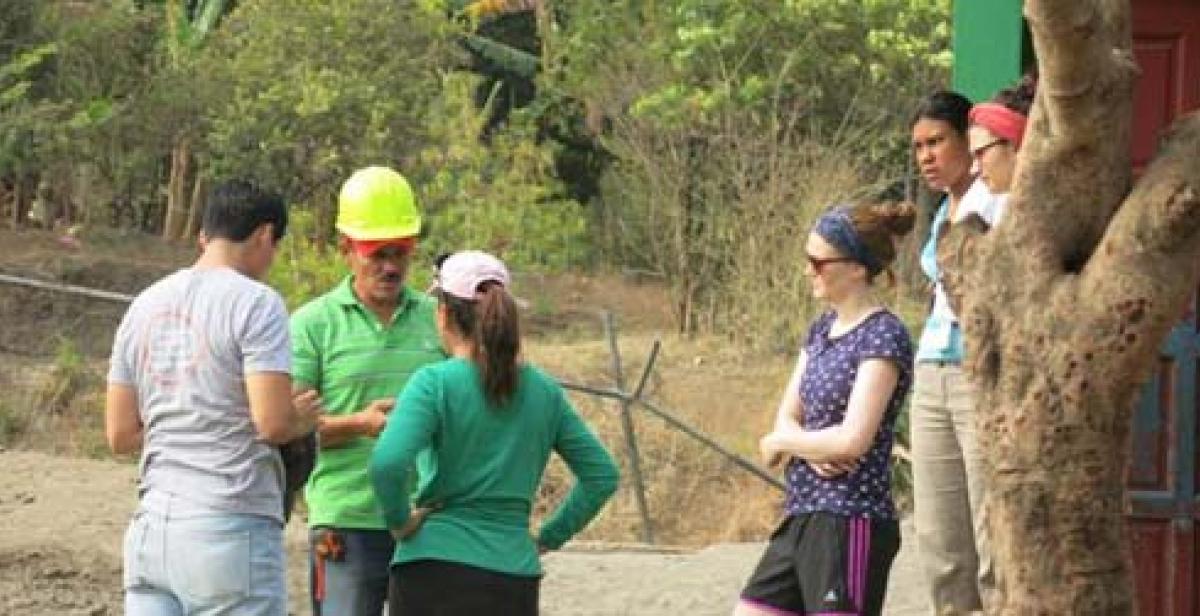In the early hours of the 8 April, we first set our feet on the site of the classroom to be. As we encircled the ‘master of work’ - the man who was to instruct us on how to build the classroom, he grimaced at us with a look of disbelief, which stated, more clearly than any words could, how he felt about working with unskilled labourers.
Unsullied by the master of work’s lack of faith in us, we grabbed our tools, pickaxes, shovels and a large rod with a flat spike on the end we dubbed the ‘ground loosener’ and enthusiastically (and rather clumsily at first) set to work on levelling out the slope on which the classroom was to be built.
After a very sweaty, dusty and blistering (both heat and hands) two days of work, we had levelled out the ground and marked out the area in which we’d be working for the upcoming weeks.
As we arrived at the school the following morning, we looked forward to the much less physically demanding task of laying bricks. Little did we know what was to come.
 Classroom starts to take shape
Classroom starts to take shape
Five one-metre cubed pits were to be chiselled out of the dry, rocky dirt that lay beneath our feet. These holes would encase the metal supports that would run up the side of the classroom.
As the master of work gave us our instructions for the day, he declared that the boys and girls would be split in two separate groups, with the boys digging the holes and the girls constructing the metal supports (despite the fact that only two people at a time could work on the supports, but there were fifteen girls all eager to work). We didn’t protest to him vocally, but simply allocated ourselves to the tasks for the day, making sure we had a perfect mix of boys and girls for each job.
As the foundations for the classroom began to take shape, the master of work understood our decision and the foundations for our relationship with the master of work also began to take shape. After another very sweaty, very dusty but ultimately very rewarding four days of work (there’s something very satisfying about digging holes), we had finished all five holes and were ready to start building upwards.
We began with setting the metal support pillars we’d constructed in place and encasing them in cement. While this may seem like a fairly simple task, mixing cement by hand is a very delicate process and felt to me like it should be something were doing in a bakery rather than on a construction site.
Five cubic metres of cement later, the metal pillars towered high and we finally started to feel like a finished classroom was within the realm of possibility. Next came the part each one of us was looking forward to; bricklaying. As the first few bricks were laid by the master of work, he chatted freely, even joked, with us. It appeared that our undying enthusiasm had finally won him over. The first few layers of bricks were set in an instant, the master of work’s clear instructions and joviality made light work of the first wall.
Now we’d established firm foundations, the walls of the classroom were easily built up, as was our relationship with the master of work.
 The finished classroom
The finished classroom
As of today, after only five weeks, the walls stand strong and high, along with the gleaming corrugated iron roof. The classroom is very near completion, with only the job of fitting the windows, laying down the tiles for the floors and painting the walls, as well as an environmentally - themed mural on the outside wall.
Our relationship with the master of work played a key role in the speed at which the classroom was erected. Once we showed him that hard work and enthusiasm shouldn’t be underestimated, we started to work together efficiently, and what seemed like an insurmountable task became only a matter of time.
By ICS volunteer Guy Brown



